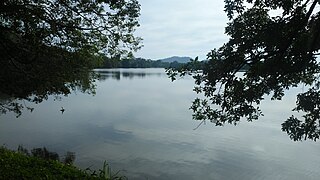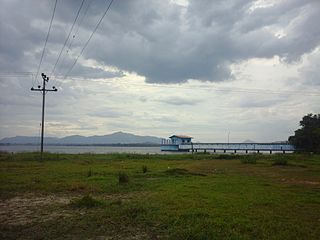The ancient Sri Lankan people excelled in the construction of tanks (Wevas) or reservoirs, dagobas, and palaces in Sri Lanka, as evident from the ruins which displays a rich variety of architectural forms.

Parākramabāhu I, or Parakramabahu the Great, was the king of Polonnaruwa from 1153 to 1186. He oversaw the expansion and beautification of his capital, constructed extensive irrigation systems, reorganised the country's army, reformed Buddhist practices, encouraged the arts and undertook military campaigns in South India and Burma. The adage, "Not even a drop of water that comes from the rain must flow into the ocean without being made useful to man" is one of his most famous utterances."

Parakrama Samudra is a shallow reservoir (wewa), consisting of five separate wewa (reservoirs) connected by narrow channels in Polonnaruwa, Sri Lanka.

Kala Wewa, built by the King Datusena in 460 CE, is a reservoir complex consisting of two reservoirs, Kala Wewa and Balalu Wewa. It has the capacity to store 123 million cubic meters of water. This reservoir complex has facilitated with a stone made spillway and three main sluices. From the central major sluice, a 40 feet wide central conveys water to feed thousands of acres of paddy lands and ends at the historical capital Anuradhapura city tank Tissa Wewa meandering over 87 km (54 mi) at a slope of 6 inches per mile and is another wonder of primeval hydraulic engineering facility in ancient Ceylon.
Pandukabhaya was a king of Upatissa Nuwara and the first monarch of the Anuradhapura Kingdom and 6th over all of the island of Sri Lanka since the arrival of the Vijaya; he reigned from 437 BC to 367 BC. According to many historians and philosophers, he is the first truly Sri Lankan king since the Vijayan migration, and also the king who ended the conflict between the Sinha clan and the local clans, reorganising the population.

The Anuradhapura kingdom, named for its capital city, was the second established kingdom in ancient Sri Lanka. According to the Mahāvaṃsa, it was founded by King Pandukabhaya in 437 BC, whose authority extended throughout the country.
Vasabha was a monarch of the Anuradhapura period of Sri Lanka. He is considered to be the pioneer of the construction of large-scale irrigation works and underground waterways in Sri Lanka to support paddy cultivation. 11 reservoirs and 12 canals were constructed during his reign. He also constructed several Buddhist temples in addition to renovating already existing ones. Vasabha started a new dynasty in the history of Sri Lankan monarchs, having seized the throne after killing Subharaja, the then ruler of Anuradhapura.

The Anuradhapura period was a period in the history of Sri Lanka of the Anuradhapura Kingdom from 377 BCE to 1017 CE. The period begins when Pandukabhaya, King of Upatissa Nuwara moved the administration to Anuradhapura, becoming the kingdom's first monarch. Anuradhapura is heralded as an ancient cosmopolitan citadel with diverse populations.

Abhaya Wewa, historically Abhayavapi or Bassawakkulama reservoir, is a reservoir in Sri Lanka, built by King Pandukabhaya who ruled in Anuradhapura from 437 BC to 367 BC, after constructing the city.

Rajarata was one of three historical regions of the island of Sri Lanka for about 1,700 years from the 6th century BCE to the early 13th century CE. Several ancient cities, including Tambapanni, Upatissa Nuwara, Anuradhapura and Polonnaruwa, were established as capitals within the area by successive rulers. Rajarata was under the direct administration of the King. Two other areas, Mayarata and Ruhunurata, were ruled by the king's brothers "Mapa" and "Epa". The Magha invasion in the 13th century brought about the end of the Rajarata kingdom.
The Basawakkulama inscription or Abhayavāpī inscription is a rock-cut record, from the time of king Mahanama (412-434), documenting some donations made to a Buddhist establishment named Nekari Vehera. The inscription is at Anuradhapura.

Thonigala Rock Inscriptions are two Elu-language inscriptions engraved on a rock situated in Anamaduwa of Sri Lanka, written in Brahmi alphabet. Each inscription is about 100 feet long and each letter is about one feet in height and engraved about one inch deep in to the rock. Also it is said to be the largest rock inscription found in Sri Lanka.

The Rambakan Oya Dam is an embankment dam in Maha Oya, Eastern Province, Sri Lanka. The reservoir was designed and constructed by the Sri Lanka Mahaveli Authority and currently functions under the direction of the Ministry of Irrigation and Water Resources Management. It has been created by building an Earthen dam which is about 1,225m in length across the Mundeni Aru river.
Giant's Tank is an irrigation tank in northern Sri Lanka, approximately 10 mi (16 km) south east of Mannar.

Sorabora Wewa is an ancient reservoir in Mahiyangana, Badulla District Sri Lanka. It is thought to have been constructed during the reign of King Dutugemunu by a giant named Bulatha. In the ancient past, this tank was known as the 'Sea of Bintenna'.

Panduwasnuwara is an ancient capital, situated in Kurunegala District, Sri Lanka. It is said to be the controlling centre known as Parakramapura of Dakkhinadesa in the 12th century, when it was ruled by Parakramabahu. The remaining ruins of the ancient kingdom still can be seen at Kotampitiya area which lies along Wariyapola-Chilaw main road about 19 km (12 mi) away from Wariyapola town. Panduvasnuwara is located at a distance of 3 km from Hettipola and 18 km from Kuliyapitiya.

Konduwattuwana Wewa or Kondawattuwana Wewa is an ancient reservoir located in Ampara, Sri Lanka. The reservoir lies on the Ampara – Inginiyagala main road, approximately 4 km (2.5 mi) away from the town of Ampara. The site with ancient Buddhist ruins belonging to the Konduwattuwana reservoir area is formally recognised as an archaeological site in Sri Lanka.

Yoda Ela or Jaya Ganga, an 87 km (54 mi) long single banking water canal carrying excess water to Tissa Wewa reservoir from Kala Wewa reservoir in Anuradhapura. The Yodha Ela is known for achieving a rather low gradient for its time. The gradient is about 10 centimetres per kilometre or 6 inches per mile.

The tank cascade system is an ancient irrigation system spanning the island of Sri Lanka. It is a network of thousands of small irrigation tanks draining to large reservoirs that store rainwater and surface runoff for later use. They make agriculture possible in the dry-zone, where periods of drought and flooding otherwise make it difficult to support paddy fields and livestock.
Padaviya is a historic town in the Anuradhapura District of the North Central Province, Sri Lanka.















